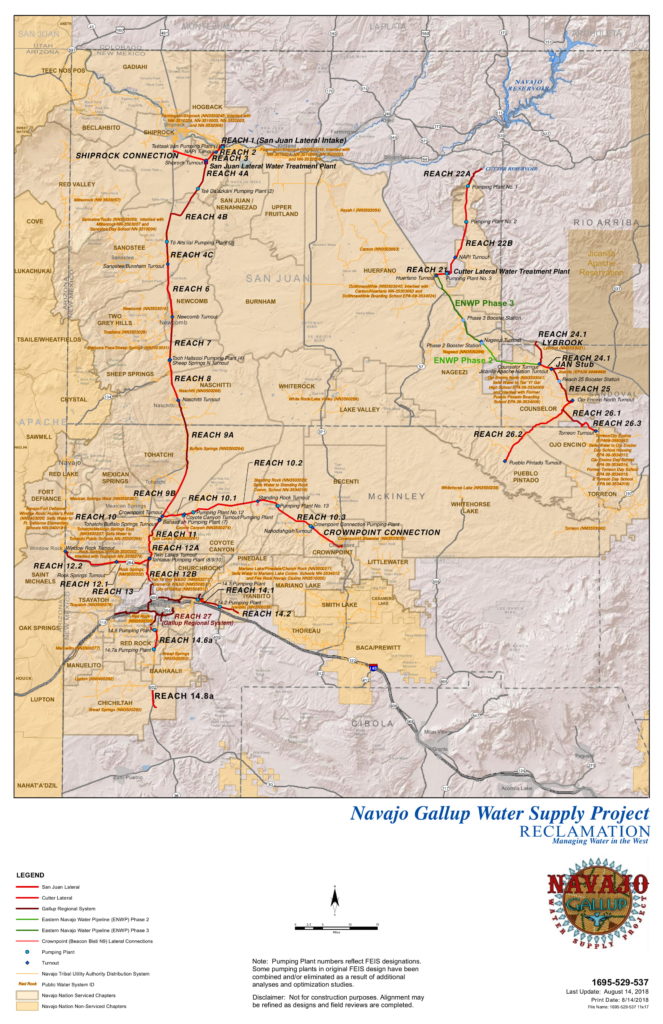The United Nations defines water as a basic human right. Yet 40% of Navajo households do not have running water (Navajo Water Project, 2018).
Those without access to water must either drive long distances and haul water from cities, haul water by hand from distant wells, or have water delivered. Many water sources that are accessible may be contaminated with uranium and arsenic. A 2016 publication shows that 12.8% and 15.1% of water wells exceed the maximum contamination levels of uranium and arsenic respectively (Hoover et. al, 2016).
The lack of access to clean, safe water presents a barrier to Diné safety, health, and well-being. Below is information outlining the current status of water usage in the Navajo Nation.
Who are the people using water?
According to the 2010 US Census, the population of the Navajo Nation is 173,667, which is a 3.9% decrease from the population in 2000. Of that population, 33% are under the age of 18 and 10% are over the age of 65. The majority of households are home to families, and these households are almost three times more likely to be multi-generational than households in the neighboring state of Arizona; the average household size in the Navajo Nation is 3.4 persons, as compared to the Arizona state average of 2.6 persons. (Demographic Analysis of the Navajo Nation Using 2010 Census and 2010 American Community Survey Estimates, 2010). As such, water delivered or hauled must serve more people per household than in other non-Navajo communities.
The Navajo Nation is largely rural, with a population density of just 6.33 persons per square mile. Only 9% of Navajo Nation residents live in border towns, or towns located close or on the boundaries of the reservation. A majority of Navajo Nation residents in border towns are under the age of 30 (Navajo Population Profile 2010 U.S. Census, 2013). The widespread distribution of Navajo homes thus makes transportation of water much more costly.
Transporting and decontaminating water is costly on the reservation, and a lack of available economic resources exacerbates the problem. The Navajo Nation experiences high poverty and unemployment rates as compared to the United States averages – 38% of all residents and 44% of children are living below the poverty line (Demographic Analysis of the Navajo Nation Using 2010 Census and 2010 American Community Survey Estimates, 2010). The median household income within the Navajo Nation is $27,389 (Nania, Cozzetto, et al. 2014), and nearly a third of households have an income of less than $15,000; the nearby city of Flagstaff, Arizona has a median household income of $51,340 and the median household income of the United States, $55,322, is more than double that of the Navajo Nation (US Census Bureau, 2016). In addition to this, the Navajo Nation has an average unemployment rate of 15.6%, with local unemployment rates ranging from 6% to 57% (Nania, Cozzetto, et al. 2014).
Where does the Diné community get its water?
Wells and springs
Many Navajo residents retrieve water for livestock, drinking, and general use from wells pumped by windmills or springs, which are often unregulated sources (Gies, 2016), often travelling great distances to get to these sources. The lack of regulation presents potential dangers for uranium, arsenic, and biological contamination. Otherwise, these wells or springs may be unreliable in water availability. For instance, one student of Navajo Technical University stated that he had no access to running water for 21 years, due to the lack of a reliable water source in his town. It was not until he was 23 years old that he gained access to running water. This is not an uncommon situation in the Navajo Nation.
The Navajo Tribal Utilities Authority
The Navajo Tribal Utilities Authority (the NTUA) is a Navajo Nation enterprise which helps provide utilities such as water, electricity, natural gas, and more. From our contact with the NTUA, we know that there are 300 currently serviced water storage tanks and 7-9,000 miles of PVC distribution lines to reach 36,000 customers. These distribution lines stem from 111 systems (evaporative disposal, discharging systems, activated sludge, and membrane filtration) to treat wastewater; all systems are checked on a weekly basis for sanitation levels and functionality. Officially, the records show that there are over 4,000 homes that are not serviced. Unofficially, there are probably anywhere from 11,000 to 15,000 unserved homes (Shulz, 2018). Many residents receive water from the NTUA that is taken from the San Juan river, diverted through the Navajo Dam, a large dam built in 1962.
Navajo-Gallup Water Supply Project
The Navajo-Gallup Water Supply Project is a major project currently under construction and due to be finished in 2025. It is projected to provide water to 90% of the remaining people in the project service area without running water and plans to draw water from the San Juan River and deliver it to this project service area, defined by “the eastern section of the Navajo Nation, southwestern portion of the Jicarilla Apache Nation, and the city of Gallup, New Mexico via about 280 miles of pipeline, several pumping plants, and two water treatment plants,” (US Bureau of Reclamation, 2009). The map below shows the plans for construction of pipelines through the pipeline project and existing NTUA pipelines.

How much water is used on the reservation?
Water usage per capita in the Navajo Nation is significantly less than in communities off the reservation in the region. According to the table below, which was produced by the Navajo Nation Department of Water Resources, approximately 40% of Navajo households must haul water or don’t receive water through pipelines, and these households use only about 10 gallons of water per day per person. In households with running water, about 100 gallons of water are used per day per person. But this is still only half of the estimated per capita use in non-Navajo communities in the region, which is roughly 200 gallons per day (Singer, 2014).

How is water used on the reservation?
According to the table above, about 12,000 acre-ft per year are used for domestic purposes. This represents only about 3% of the total annual water use. The other main water usages come from the agricultural and industrial sectors.
Agriculture
Agriculture, which inherently necessitates water use, has been a longstanding tradition and cornerstone of Diné culture. The Navajo Nation Department of Agriculture calls livestock and crop farming “timeless symbols of resourcefulness, prosperity and social status” which are “gifts bestowed by Holy Ones” (Navajo Nation Department of Agriculture, 2018). Small subsistence farms have been common throughout the nation in the past, but traditional farming has been declining in part due to general movement toward Western cultural ideas (Sustainable Agriculture Research & Education, 2018). Still, there are nearly 14,500 farms on the Navajo Nation, with most of these being subsistence farms – 69% of farms reported sales less than $1000 annually (Arizona Farm Bureau, 2017). Small subsistence farms account for a much smaller percentage of water usage than the Navajo Agricultural Products Industry, or NAPI, an enterprise created by the Navajo Nation in 1970 to operate NIIP land.
NIIP is the Navajo Indian Irrigation Project, a project that began in 1964 and allocated approximately 110,000 acres of land to be irrigated (US Department of the Interior, 2018) drawing 206,000 gallons annually from the San Juan River, diverted from the Navajo Dam. Approximately 70,00 acres of land are currently irrigated, but a lack of funding leaves the remaining 40,000 acres of land still to be utilized and irrigated (US Department of the Interior, 2018).
Water use for livestock watering represents a significantly smaller amount than other usages, estimated in 1993 to be only about 865 acre-ft per year (US Bureau of Reclamation, 2009). Because of this, we did not focus on water conservation/usage for livestock, especially since sources for drinking water, which we hope to improve, can be and are already shared as sources for livestock watering.
Agriculture in total, including both small farms and Navajo Indian Irrigation Project, comprises 78% of the total annual water use, as can be calculated from the table. Water use in agriculture in Arizona uses only 68% of the total water use annually (Arizona Department of Water Resources, 2018), and thus agricultural water use should be an important aspect of water management.
Water use on land in the NIIP alone accounts for about 52% of water use annually according to the table; however, the NAPI enterprise, as found in 2003, is actually considered at low risk for water shortages (Nania, Cozzetto, et al. 2013). Due to the fact that it is projected to have a steady source of water and the low feasibility of making drastic changes to this well-established program, our strategies for decreasing water waste in agriculture focuses on smaller scale farms that are common across the nation.
Industry/mining
Industry and mining on the Navajo Nation account for about 20% of annual water use by volume, according to the table. A combination of industrial plants and mostly coal mines comprise this sector of water use. Although this sector accounts for a substantial amount of water usage in the nation, Mission 2022 decided not to address this issue due to conversations with Diné in which they emphasized the importance of getting water to households, rather than reducing industrial use.
What is the quality of water in the Navajo Nation?
Water across the Navajo Nation, especially in areas close to mines, is highly contaminated, with one study finding that 12.8% and 15.1% of sources exceeded the uranium and arsenic maximum contamination limits respectively, and sources close to mines (within 6.4 km) were 6.3% and 8.3% more likely than other sources to surpass the arsenic and uranium limits respectively (Hoover et. al, 2016). The EPA links exposure to arsenic contamination to skin damage, circulatory system problems, and possible increased risks of cancer. The EPA links exposure to uranium contamination to increased risks of cancer and kidney toxicity. Exposure to bacteria and biological contaminants present in unregulated water sources on the Navajo Nation can lead to a range of diseases and symptoms, including E. coli, Giardia, enterovirus, and many others. As indicated by the Centers for Disease Control, some of these biological contaminants may be a result of unsafe water hauling and storage practices in addition to drawing from unregulated sources (Centers for Disease Control, 2016).
The level of contamination considered safe by the EPA depends on its intended usage, either domestic or agricultural. The EPA defines these varied categories as domestic water supply, primary human contact (submergence and/or ingestion), secondary human contact (not to the point of submergence and/or ingestion), agricultural water supply, and livestock watering. By using these standards, filtration techniques can vary based on need. For instance, water utilized for agriculture can be anywhere from 4.5 to 9.0 in pH while water for ingestion (PHC) must be within 6.5 and 9 in pH.
More information about these levels and the effects of these chemicals on the body can be found on the EPA National Primary Drinking Water Regulation Table
Some treatment systems are in place to reduce the amount of contaminants, but often the levels considered “suitable” for human consumption by the EPA may be harmful to long term health. For instance, a NIH study linked small amounts of arsenic intake in pregnant Navajo women and increased oxidative stress, a potentially dangerous imbalance in the human body (Dashner-Titus et. al, 2018). This may lead to both health concerns and greater distrust in water sources from the Diné.
Contaminant Map
Below is a map plotting the location of known Arsenic and Uranium sources across the Navajo Nation, as well as the the area encompassed by the Bodaway-Gap Chapter. This map was a large factor in understanding how to localize solutions toward communities and identify regions facing a high risk of losing water security in the future (EPA 2010).
Navajo Nation
| Arsenic | |
| Uranium Mines | |
| Bodaway Chapter |
| Population Density |
Climate Change
Climate change has already started to affect the Navajo Nation and is projected to continue to have detrimental impacts on moisture balance (which is based off of soil moisture and drought severity indexes) and general water availability (Cook, et. al, 2015). The Nation is currently under the stress of a 17-year drought, and drought is only projected to increase.
Diné Perspectives
An important priority was using Diné perspectives to guide our solutions so that they could be compatible with and respectful of Diné culture. We tried to accomplish this and gain broader based approval by consulting with a range of Diné, including students, elders, and professors through class visits, phone and video calls, and emails.
Our Focus
Taking into consideration the priorities emphasized through multiple conversations with Diné people, we decided to focus on providing clean, safe water to households. Additionally, because agriculture is such an integral part of traditional Diné culture, we looked into some methods to conserve water in agriculture that we hope can be of use in reducing water usage and lead to more sustainable farming.


